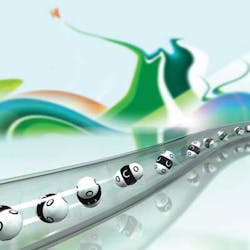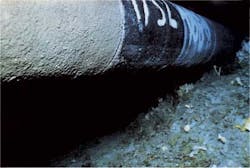Offshore industry examines integrity of CO2 pipelines
Jock Brown
Sigbjørn Røneid
Mohammad Ahmad
Angunn Engebø
DNV GL – Oil and Gas
With energy security and climate change at the top of the global agenda, climate change mitigation technologies such as carbon capture, utilization and storage (CCUS) are gaining momentum. The number of offshore CO2 pipelines is therefore expected to grow significantly in the future.
CCUS technology offers a solution for both supporting production of incremental hydrocarbon reserves from existing fields while at the same time storing CO2 away from the atmosphere, avoiding climate impacts. As fossil-based fuels continue to be part of the energy mix in the foreseeable future, CCUS will be critical, particularly for reducing emissions from coal-fired power plants. The push to unlock high CO2 stranded gas fields is also likely to spur the development of CO2 pipeline technology offshore.
In Europe, Brazil and Southeast Asia, the most advanced CO2 storage sites are offshore. The demand for such facilities is driving the need for reliable transportation pipelines from onshore sources to offshore storage sites. The public acceptance issue for onshore storage is another driver for the offshore storage business. As well as the clear advantage to the environment, the injection of CO2 in offshore oil and gas reservoirs could extend the lifetime of the well through enhanced oil recovery (EOR).
Opportunities for the offshore storage of CO2 are prevalent in the North Sea with projects underway off the UK and Norway. There are also opportunities in offshore Brazil and China. Regarding sour gas developments and the trend of increasing use of LNG in Southeast Asia, there is an expectation that more of these "stranded" gas fields will be developed.
Transferrable technology
Transportation of CO2 is generally considered the easier part of CCUS, since the pipeline sector is well established and the technology is well known. However, closing existing knowledge gaps associated with the flow dynamics and assurance of CO2 pipeline transport has the potential to reduce uncertainty and avoid unnecessary high safety margins.
The technology for conveying CO2 is typically the same as that for any other gas and liquid pipelines offshore. From the outside, it would be difficult to tell the difference between a CO2 pipeline and a natural gas pipeline. The key differences can be found on the inside.
The thermodynamic and corrosive properties of pure CO2 are different from those of other fluids, such as natural gas, conveyed in pipelines. The presence of impurities in the CO2 stream, like those from anthropogenic sources, adds another level of complexity. Understanding how CO2 disperses into the atmosphere during planned, as well as accidental release scenarios is essential for pipeline route planning and risk assessment of pipeline design. This understanding can be used to demonstrate the effect on pipeline design and is essential to construct cost-effective and safe offshore CO2 pipeline solutions.
Research around the world is building on enhancing the understanding of the science and fundamental properties of CO2, in particular the thermodynamic and corrosive properties. The main body of work currently being undertaken builds on the experiences of operating pipelines carrying pure natural CO2 for the EOR industry in North America.
Collaborative research
Joint industry projects (JIPs) are playing a major role in the research effort toward CO2 pipelines. DNV GL-led JIPs such as COSHER and CO2PIPETRANS have filled many of the knowledge gaps associated with CO2 pipeline transport.
Results from the CO2PIPETRANS project, which involved 15 JIP partner organizations, focused on the implications of the thermodynamic and corrosive properties in a CO2 pipeline. The project investigated the dense phase CO2 release model validation data, fracture arrest and corrosion on the transportation component of CCUS projects with the aim of updating recommended practice, DNV RP-J202 for the design and operation of CO2 pipelines.
Computer simulations of dispersion were used to assess the potential consequences of an accidental release from a pipeline. Previously, CO2 pipelines have been designed using unverified computer simulations, due to the lack of experimental data. Data made available by CO2 PIPETRANS can be used to validate computer simulations used in CO2 pipeline design, thus optimizing the design process.
The important technical and financial contributions of such collaborative initiatives illustrate the importance the industry has placed on the issue. This wealth of knowledge has led to the initiation of another JIP to undertake experiments releasing CO2 through a water column to understand its dispersion and dissolution. The "CO2 Subsea Releases – Small Scale Experimental Programme" currently involves several major operators including National Grid, Eni, and Petrobras, and more participants are welcome to join the project.
The JIP will explore CO2 subsea releases by generating data from well-defined experiments under different conditions of leak size, pressure, water depths, and direction of the release. Simulation of punctures, as well as ruptures, will be carried out at DNV GL's world-class Spadeadam Test Site. State-of-the-art computational fluid dynamics (CFD) models will be employed to investigate the applicability and accuracy of current modeling techniques against the recorded experimental data. The purpose of this is to identify opportunities for modeling improvement and to provide guidance for modelers undertaking leak consequence assessments.
The DNV GL Recommended Practice "DNV-RP-J202 Design and Operation of CO2 Pipelines" will be updated to reflect the new knowledge and help ensure that the highest safety standards are met when transporting CO2. This RP is one of a number of widely-adopted industry guidelines developed by DNV GL for CO2 handling, such as Recommended Practices for CO2 Capture, CO2 Pipelines and CO2 Geological Storage.
Standards and recommended practices
The subject of CO2 transportation by pipeline is of widespread and increasing importance as many governments and communities worldwide come to terms with the issues of carbon capture and storage for the mitigation of climate change. The transportation aspect is often looked upon as the "missing link" in a concept that is already being widely embraced.
DNV GL has created a series of internationally recognized standards and recommended practices together with the pipeline industry. Since 1976, DNV GL has issued a number of pipeline codes, comprising service specifications, standards, and recommended practices that are currently widely used by the industry.
The key challenge for CCS and the transportation of CO2 are the ongoing international negotiations and debates for a firm and unified agreement on climate change. The likelihood of this happening in the near future remains uncertain, and this in turn has made many industry players reluctant to commit significant budgets to solving many of the outstanding issues. However, this does not mean that innovation and technology development is standing still. R&D work continues to examine solutions that will optimize design, reduce costs, and continue efforts to build pipeline infrastructure.






